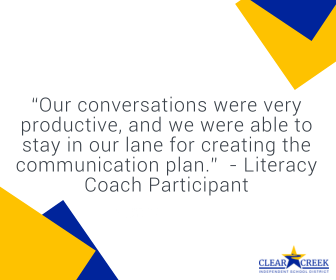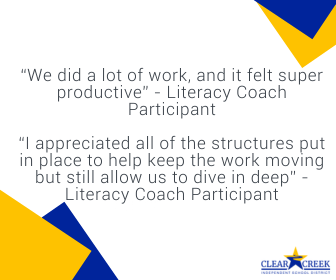
Unlocking Literacy for All: How Clear Creek ISD Planned and Executed Instructional Change
Personalized Learning | Education Elements | School Districts | District Leadership | School Leadership
Nation-wide, building literacy in our children is a persistent challenge. So much of a challenge that according to the National Assessment of Educational Progress, more than 60 percent of American fourth graders are not proficient readers. Other research has shown that 95% of students are cognitively capable of reading proficiently, which indicates that lacking literacy isn’t the result of students’ capabilities; it’s the consequence of instruction failing to access and amplify students’ potential as readers and writers.
The implications of this are serious. It’s often said that reading opens doors. For students who can’t read proficiently, many of those doors remain closed and the paths behind them go unexplored, so further opportunities to learn, grow, and achieve are rendered inaccessible.
Significant efforts to spur literacy development are underway. As the Science of Reading movement scales and spreads across the country, leaders and teachers are learning more about the best ways to boost literacy and close the opportunity gap. But given how much there is to learn - and how today’s best practices vastly differ from what so many believed to be “the right way” just years ago - for many districts, shifting instruction to align with the Science of Reading is a complex organizational change endeavor. It touches on every pillar of instruction, including curriculum, instructional design, and professional development.
In the winter of 2022, looking for a way to refine and align a number of shifts to literacy instruction already underway in her district, Clear Creek ISD decided to apply for Texas Education Agency’s (TEA) Strong Foundations Planning grant. This grant is part of a TEA initiative developed largely in response to the previously-mentioned data on students’ lacking literacy development. The Strong Foundations Planning grant “strategically allocates funds to assure that all [Texas] districts can create instructional frameworks aligned to the research-based instructional strategies (RBIS) that serve as tools for districts to make instructional decisions.” Given its attention to promoting strategic clarity while facilitating further learning about instructional best practices, Hughes thought the grant was a great fit for where Clear Creek ISD was and where she wanted to lead it moving forward.
In spring 2023, Clear Creek ISD found out they got the grant. Now, it was time for Clear Creek to partner with an approved provider who would support project management, RBIS training, constituent engagement, and the drafting of the instructional framework.
From 2021-2023, Clear Creek ISD collaborated with Education Elements to implement Personalized Learning in elementary schools throughout their district. Similar to the Strong Foundations Planning grant, this work required a blend of vision setting, strategizing, and supporting implementation. Given the success of their Personalized Learning work, Clear Creek ISD’s district leaders decided to once again team up with Education Elements to facilitate the development of their instructional framework for literacy.
Our Strong Foundations Planning work with Clear Creek ISD kicked off in August 2023, when we formed a Steering Team of 15 Clear Creek ISD elementary staff members from various positions across the district and gathered in-person for our first strategy session. We spent a whole day together reflecting on the current state of literacy instruction at the district, reviewing the requirements of the Strong Foundations Planning grant, and aligning on the most exciting opportunities the grant presented to Clear Creek ISD based on their unique needs, context, and goals. When asked for feedback, one member of the district steering team described the kickoff of our Strong Foundations work as “purposeful and meaningful” while another said our first session together was “very well done; it all flowed smoothly and [contained] great relevant information.”
With Clear Creek’s current state and future hopes established, we began the work of building a bridge that covered the gaps. In October 2023, we delivered two days of training on the RLA RBIS to the Steering Team. These trainings provided Steering Team members with an opportunity to internalize both “the what” and “the why” of critical science-backed strategies for supporting all students in developing literacy, and they gave the Steering Team space to consider how these strategies could best fit into instruction in their context. At the end of these two days, the CCISD steering team produced their first outline for their upcoming instructional framework.
With the RBIS as a north star, the Steering Team reconvened in November 2023 to write the first draft of Clear Creek ISD’s instructional framework for literacy. Throughout the full-day brainstorming session, we guided the Steering Team through developing a district-wide vision for literacy instructions, cementing core beliefs that would lead the district to achieve that vision, and outlining essential actions that gave all constituents through the district clarity on how they could live out the district’s beliefs about literacy. This session was demanding, but at its conclusion, participants expressed that the challenge was worthwhile and made more manageable by EE’s unique approach to facilitating collaboration. When asked what they enjoyed about this session, participants cited “the process and scaffolds provided” and “the structures and activities that promoted the drafting.”
We spent November engaging various constituents throughout the district to get their feedback on the draft. With that community input in mind, the Steering Team met again in December for one more round of revisions. After spirited debate and passionate discussion, they had it - their overarching instructional framework for literacy was born! The TEA recently selected this instructional framework as an exemplar for other districts that participate in the Strong Foundations Planning grant as it contained the types of alignments and refinements it wants to showcase.
The initial impact of the framework was felt immediately. As leaders, coaches, and teachers were introduced to the framework, they consistently reacted with relief and appreciation. As many of them said, the framework provided clarity on how they could best align their work with the district’s goals and priorities.
Creating the framework was only the beginning. With the strategic direction clarified and externalized, Clear Creek ISD next had to plan for introducing and implementing the framework across the district. To ease implementation, we worked with ELA Coordinator Karen Hearn to identify what instructional shifts needed to be prioritized in the coming school year for the framework to come to life quickly. Through an extensive gap analysis, she and other CCISD district leaders identified the priority areas for implementation in the upcoming school year to include providing RLA RBIS training to all CCISD elementary teachers, piloting HQIM in select grade bands, and strengthening implementations of Reading Horizons, a program for providing foundational skills instruction.
These priority areas clarified our goals for implementation, but knowing input is essential to investment and execution, we wanted even more voices from across Clear Creek ISD to be involved in writing the plans for each priority area. So, we formed a new team to guide this next phase of work.
Composed mostly of campus-based literacy coaches, this team met for 2 days of intense, detailed planning in February 2024. Working in small sprint teams, coaches collaboratively determined the impact they hoped to achieve by working within each priority area in the coming year. They decided which objectives would be essential to making the impact they aimed for, and they wrote the action plans they believed would lead Clear Creek ISD to reach all of its objectives. Coaches created comprehensive and actionable implementation plans, and they left these sessions with both clarity on what to expect ahead and a deep motivation for continuing to lead implementation moving forward.
The path to bridging the opportunity gap is long, and time is of the essence for our students. From that perspective, Clear Creek ISD’s Strong Foundations Planning work has been important and inspiring. Only 6 months after truly beginning its Strong Foundations Planning grant, Clear Creek ISD updated its knowledge on research-based best practices for literacy instruction, created an exemplary instructional framework for literacy, and developed comprehensive implementation plans that will turn the vision and beliefs of its framework into the culture and instruction of their classrooms.
About Megan Campion
Megan Campion is Partner with Education Elements, working with schools, districts, regional education agencies, and state departments of education to support effective change management for continuous improvement. Megan came to Education Elements in 2018 with extensive experience working in schools as a teacher and administrator, and with schools as a program manager and consultant. Megan began her teaching career as a kindergarten teacher at an independent school in McLean, Virginia. She transitioned into teaching middle school history in her second year of teaching, and spent her time as a teacher creating student-centered, inquiry-based learning experiences for students. She worked with the Alliance to Save Energy as the national manager for the Green Schools (later named PowerSave Schools) program, a K-12 service learning program that supported students’ work to measure and conserve the electricity usage in their school buildings. She went on to work with a technology and research company as an associate director of research, working with school districts across the country on school and district climate studies, leadership transition plans, and community engagement projects. Megan’s career in education has been centered around the question of what is effective, scalable, and measurable in education, and supporting the development and engagement of all stakeholders in a school community.






